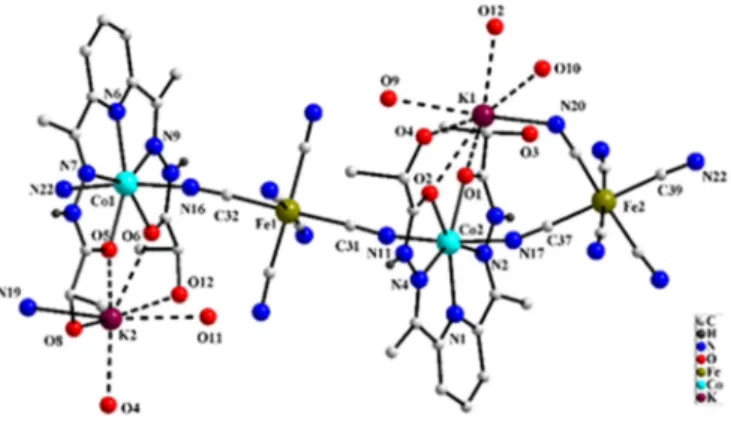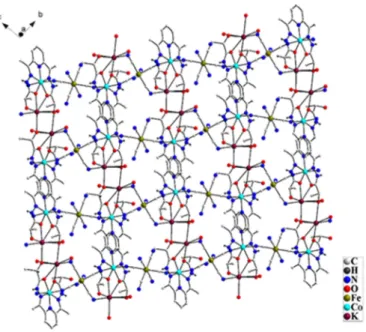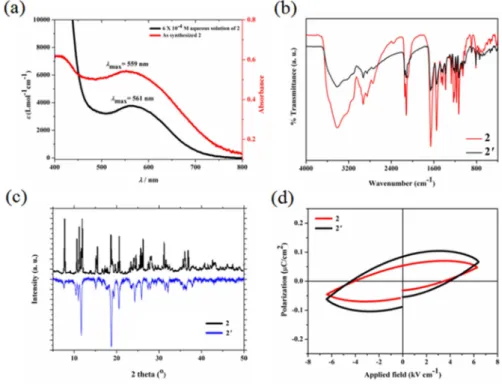HAL Id: hal-03131086
https://hal.archives-ouvertes.fr/hal-03131086
Submitted on 4 Feb 2021HAL is a multi-disciplinary open access archive for the deposit and dissemination of sci-entific research documents, whether they are pub-lished or not. The documents may come from teaching and research institutions in France or abroad, or from public or private research centers.
L’archive ouverte pluridisciplinaire HAL, est destinée au dépôt et à la diffusion de documents scientifiques de niveau recherche, publiés ou non, émanant des établissements d’enseignement et de recherche français ou étrangers, des laboratoires publics ou privés.
Accessing water processable cyanido bridged chiral
heterobimetallic Co(II)-Fe(III) one dimensional network
Anup Choudhury, Céline Pichon, Jean-Pascal Sutter, Dobbidi Pamu, Bipul
Sarma, Prashurya Mudoi, Nayanmoni Gogoi
To cite this version:
Anup Choudhury, Céline Pichon, Jean-Pascal Sutter, Dobbidi Pamu, Bipul Sarma, et al.. Accessing water processable cyanido bridged chiral heterobimetallic Co(II)-Fe(III) one dimensional network. Chemical Communications, Royal Society of Chemistry, 2021, 57, pp.207-210. �hal-03131086�
1
Accessing water processable cyanido bridged chiral heterobimetallic
Co(II)-Fe(III) one dimensional network
Anup Choudhury,a Céline Pichon,b Jean-Pascal Sutter,b Dobbidi Pamu,c Bipul Sarma,a Prashurya Pritam
Mudoia and Nayanmoni Gogoi*a
a
Department of Chemical Sciences, Tezpur University, Napaam-784028, Sonitpur, Assam, INDIA. Email: ngogoi@tezu.ernet.in
b
Laboratoire de Chimie de Coordination du CNRS(LCC-CNRS), Université de Toulouse, Toulouse, France c
Department of Physics, Indian Institute of Technology Guwahati, Guwahati, 781039,Assam, India
Abstract:
A water processable cyanido bridged extended chiral heterobimetallic Co(II)-Fe(III) network is assembled. The unusual water processability of the coordination polymer originate from dangling hydrophilic substituents. The present approach offers a simple route to impart solution processability in cyanido bridged molecular magnetic materials.
2
Endowing multifunctionality in molecular magnetic materials has emerged as one of the most compelling challenge for their eventual application in construction of nanoscale devices.1 In this
regard, considerable interest has been focused for the development of molecular magnets decorated with a range of intertwined characteristics e.g. guest or light responsive magnetism, magnetocaloric effect, conductivity, multiferroicity, magnetochiraldichroism etc.2 Since the discovery of room temperature magnetism in Prussian blue analogues, cyanido bridged extended solids as well as molecular aggregates have gained particular importance in construction of multifunctional molecular magnetic materials.3-4 However, despite their versatile characteristics, application of such
coordination compounds in fabricating functional devices remains a distant goal so far. This can be primarily attributed to the inherent difficulty in post synthetic processing of cyanido bridged coordination polymers owing to their inherent poor solubility. Earlier studies addressed the poor processability of Prussian blue and its analogues by shape and size-controlled synthesis of nano-objects and controlled deposition of these nano-objects over various substrates. Employing reverse micelle technique, ionic liquids or stabilizing ligands allowed controlled growth of nanometer size Prussian blue nanoparticles and deposition of these particles in different matrixes e.g. polymers, biopolymers, alumina and silica have been achieved so far.5-11 However, such techniques adopted for growth and
deposition of nanoparticles are limited to Prussian blue and not yet extended to vast majority of cyanido bridged coordination networks showing multifunctional behavior. This limitation can be primarily attributed to the vulnerability of the structure and formulation of cyanido bridged architectures to reaction conditions. Thus, designing solution processable cyanido bridged extended structures remains one of the most desirable yet highly challenging task for fabrication of nanoscale devices.
Interlinking metallic spin centers by cyanido based metalloligands e.g. Fe(CN)63- have emerged as one
of the most prolific strategy for rational assembly of cyanido bridged magnetic architectures.3-4 Herein, we employ this approach to access chiral hetero-metallic cyanido bridged coordination polymer which has the unique ability to form stable aqueous colloid without employing any soluble polymer matrix. The cyanido bridged coordination polymer network reported here is decorated with covalently anchored hydrophilic groups and this remarkably augments its solution processability. Moreover, the chiral cyanido bridged chain is characterized by ferromagnetic Co(II)-Fe(III) interactions and electric hysteresis loop at room temperature. Thus, a new generation of water processable multifunctional cyanido bridged molecular magnetic materials is assembled.
3
Chiral pentagonal bipyramidal Co(II) complex, [Co(l-daplh)(H2O)2](NO3)2·2H2O (1) can be easily
prepared by reaction of Co(NO3)2.6H2O with l-daplh (Scheme S1). Single crystal X-ray diffraction
studies unambiguously established that the local coordination geometry around Co(II) in 1 is pentagonal bipyramidal (Figure S7). While donor atoms of the pentadentate bis-hydrazone ligand, l-daplh occupy the five equatorial coordination sites of Co(II) in 1, the two axial sites are occupied by labile aquo ligands. Reaction of 1 with K3[Fe(CN)6] in presence of KSCN results in the isolation of dark
brown needle shaped crystals of [{K(H2O)2}{K(H2O)}{Co(l-daplh)}2{Fe(CN)6}2]n (2) (Scheme 1). Even
though compound 2 can be isolated when the above reaction is carried out in the absence of KSCN, quality of crystals formed are considerably poor. We anticipate that thiocyanate competes with ferricyanide to occupy the axial coordination sites of Co(II). This decelerate the self-assembly of Co(II) precursor with [Fe(CN)6]3-and thereby allow formation of better quality crystals of 2 when KSCN is
used.
Figure 1: Asymmetric unit of 2. C-H and O-H hydrogen atoms are omitted for clarity.
Crystal structure of 2 supports formation of a cyanido bridged hetero-metallic Co(II)-Fe(III) extended structure. Asymmetric unit of 2 consists of two [Co(l-daplh)]2+ units linked by cyanido groups of two
[Fe(CN)6]3-units (Figure 1 & Figure S8). The pentagonal bipyramidal geometry around the Co(II) center
in the precursor complex is retained in case of both the Co(II) centers present in asymmetric unit of 2. As observed in case of 1, donor atoms from the planar pentadentate chiral ligand, l-daplh occupy the five equatorial sites of the Co(II) centers. The axial coordination sites of both the Co(II) centers are occupied by cyanido groups from two neighboring [Fe(CN)6]3- units (Co-N bond distances range
from 2.037 to 2.256 Å). This leads to the formation of cyanido bridged one dimensional polymeric structure in 2. In order to maintain electroneutrality, two K+ ions are also present within the
asymmetric unit of 2. Both the potassium ions have hepta-coordinated O6N coordination
environment but the source of coordinating oxygen atoms in both differ. One of the potassium ion (K1) is coordinated to three oxygen atoms of l-daplh ligand, two aquo ligands (O9 and O10), N (N20) atom from cyanido group from adjacent Fe(CN)6 moiety and one oxygen (O12) atom of l-daplh ligand
from neighboring cyanido bridged Co(II)-Fe(III) chain. The other potassium ion (K2) is ligated to four oxygen atoms of the l-daplh ligand, one oxygen atom of aquo ligand (O11), N (N19) atom from cyanido group coordinated to adjacent Fe center (Fe2) and one oxygen (O4) atom of l-daplh ligand from neighboring cyanido bridged Co(II)-Fe(III) chain. This interlinks the cyanido bridged Co(II)-Fe(III) chains and leads to formation of two dimensional extended network structure in 2 (Figure 2). The K-O and K-N bond distances in 2 range from 2.656(2)-3.07(2) Å and 2.87(3)-3.25(3) Å. These values are in good agreement with K-O and K-N bond distances observed in earlier reported potassium complexes.12
4
Figure 2: 2D network structure in 2
It is pertinent to note here that charge assisted self-assembly of pentagonal bipyramidal M(II) complexes (M=Mn(II), Fe(II), Co(II), and Ni(II) etc.) with cyanometallates generally yield charge neutral molecular assemblages.13-20 For example, reaction of a pentagonal bipyramidal Co(II) precursor with ferricyanide have earlier yielded a cyanido bridged pentanuclear {Co3Fe2}
aggregate.15 Thus, the ability of α-hydroxy groups in l-daplh ligand to coordinate with potassium ions
alter the typical charge assisted aggregation pattern and thereby facilitate formation of two dimensional extended structure in 2. A related observation has been recently reported.21
Figure 3: χMT versus T and M versus H (inset) behaviours of 2. Blue circles represent the experimental
data and the red solid line indicates the best fit obtained
Magnetic properties of 2 reveal a spin-chain behavior. The χMT value at 300 K is 3.05 cm3 mol-1 K and
in fair agreement with what could be expected for magnetically isolated high spin Co(II) with pentagonal bipyramid coordination sphere and low spin Fe(III) (Figure 3). On lowering the temperature, χMT value slowly increases while below 30 K it rapidly rises to reach 7.5 cm3mol-1K at 2
0.0 0.50 1.0 1.5 2.0 2.5 3.0 3.5 0 10 20 30 40 50 M ( µB ) H (kOe) T = 2 K 3 4 5 6 7 8 0 50 100 150 200 250 300 χ M T ( c m 3 m o l -1 K ) T (K)
5
K. Such behavior is characteristic for a spin array with ferromagnetic interactions. Analysis of the MT
versus T behavior by the isotropic Heisenberg exchange model for a chain of alternating spins22
permitted to estimate a ferromagnetic Co-Fe interaction of J = 2.92 ± 0.03 cm-1 with g
Co = 2.39, gFe = 2
(fixed), and zj’ = -0.162 ± 0.03 cm-1 (Hamiltonian formalism ∑ ,
, ∙ ). This
ferromagnetic interaction is consistent with the Curie-Weiss analysis (Figure S13) and with reported examples.15, 23 The field dependence of magnetization recorded at 2 K shows that magnetization
reaches 3.1 µB at 5 T. This value is lower than the saturation magnetization value expected for such a
spin system and reflects the strong magnetic anisotropy of the Co(II) and Fe(III) centers (Figure 3 inset). AC susceptibility studies performed in zero-field and with applied static field did not show any evidence for slow relaxation of the magnetization in 2 (Figure S14).
Crystallization of compound 2 in polar point group C1 warranted investigation of its electric behavior.
2 displays a field dependent hysteresis loop (Figure S16). Under 20 kV applied field, the remnant polarization (Pr) is 0.12 µC cm-2 and coercive field (Ec) is 8.5 kV cm-1. Both the remnant polarization
and coercive field observed in case of 2 are comparable to those reported in case of a chiral cyanido bridged Fe(III)-Ni(II) chain.24 Further electrical characterizations such as polarization hysteresis loop studies under variable temperatures and temperature dependence of dielectric constant measurements are currently ongoing to establish true electric nature of compound 2.25
Figure 4: (a) UV-visible spectra of 2 in solid state with solution state. Comparison between (b) FT-IR
spectra, (c) powder XRD pattern and (d) polarization versus applied electric field at 10 kV of 2 and 2′ recorded at room temperature.
Presence of aliphatic hydroxo groups coordinated to potassium ions in 2 endows considerable water processability. Addition of 10 mL distilled water to 7 mg of 2 immediately results in a transparent yellow color solution. Mass spectrometric analysis of an aliquot showed m/z values supporting persistence of oligomeric heterobimetallic fragments of 2 in solution (Figure S17-S19). Moreover, UV-visible spectrum of aqueous solution features a broad peak at max = 561 nm which is absent in the
6
spectra of the individual building blocks (Figure S20 and Figure 4a). This peak can be assigned to metal-to-metal electron transfer from Co(II) to Fe(III) and observed at 559 nm in the diffuse reflectance spectra of 2.26 Thus, ESI-MS and UV-visible studies confirmed integrity of the Fe-CN-Co
linkages in aqueous medium. The aqueous solution of 2 shows Tyndall effect indicative of formation of a colloidal suspension (Figure S21). Dynamic light scattering measurement of this solution confirms its colloidal nature by showing presence of particles of size ~125 nm (Figure S22). Interestingly, compound 2 can be recovered from its aqueous solution without alteration of its pristine properties. Both the FT-IR spectra as well as powder X-ray diffraction pattern of as synthesized 2 and the sample isolated by evaporating water from an aqueous solution of 2 (i.e. 2′) are identical (Figure 4b-4c). Furthermore, no significant differences in the electrical hysteresis loops are observed between 2 and 2′ (Figure 4d).
The chiral cyanide bridged Co(II)-Fe(III) heterobimetallic 1-D network described here constitute hitherto unknown example of water processable cyanido bridged material. Upon dissolution in water, 2 forms stable colloidal suspension containing particles of average size 125 nm. Further, it can be easily isolated back from the aqueous colloid, without any loss of structural integrity by evaporating the solvent. The simple strategy adopted here to endow water processability to polymeric cyanido bridged aggregates open fascinating frontiers for fabrication of nanoscale devices by employing multifunctional cyanido bridged molecular magnetic materials.
References
1) L. Ouahab, Pan Stanford Publishing Pte. Ltd.: Singapore, 2013; D. Maspoch, D. Ruiz-Molina and J.Veciana, Chem. Soc. Rev.,2007, 36, 770; M.Clemente-León, E. Coronado, C. Martí-Gastaldo and F. M.Romero, Chem. Soc. Rev., 2011,40, 473.
2) E. Coronado, Nat. Rev. Mater., 2020, 5, 87.
3) S. Ferlay, T. Mallah, R. Ouahès, P. Veillet and M. Verdaguer, Nature, 1995, 378, 701; M. Verdaguer, A. Bleuzen, V. Marvaud, J. Vaissermann, M. Seuleiman, C. Desplanches, A. Scuiller, C. Train, R. Garde, G. Gelly, C. Lomenech, I.Rosenman, P. Veillet, C. Cartier and F. Villain, Coord. Chem. Rev., 1999, 190, 1023.
4) L. Catala, F. Volatron, D. Brinzei and T. Mallah, Inorg. Chem.,2009, 48, 3360; D. Aguilà, Y. Prado, E. S. Koumousi, C. Mathonière and R. Clérac, Chem. Soc. Rev., 2016, 45, 203; H. Tokoroa and S. Ohkoshi, Dalton Trans., 2011,40, 6825;J. Long, Y. Guari, R. A. S. Ferreira, L. D. Carlos and J. Larionova, Coord. Chem. Rev., 2018, 363, 57; M. Atzori, I. Breslavetz, K. Paillot, K. Inoue, G. L. Rikken, and C. Train, J. Am. Chem. Soc., 2019, 141, 20022; J. Wang, J. J. Zakrzewski, M. Heczko, M. Zychowicz, K. Nakagawa, K. Nakabayashi, B. Sieklucka, S. Chorazy, and S. I. Ohkoshi, J. Am. Chem. Soc., 2020, 142, 3970.
5) S. Vaucher, M. Li and S. Mann, Angew. Chem., Int. Ed., 2000, 39, 1793. 6) G. Clavel, J. Larionova, Y. Guari and C. Guérin,Chem. –Eur. J., 2006, 12, 3798.
7) E. Chelevaeva, Y. Guari, J. Larionova, A. Trifonov and C. Guérin, Chem. Mater., 2008, 20, 1367.
8) T. Uemura and S. Kitagawa, J. Am. Chem. Soc. 2003, 125, 7814.
9) Y. Guari, J. Larionova, K. Molvinger, B. Folch and C. Guérin, Chem. Commun., 2006, 2613. 10) S. Shingubara, J. Nanopart. Res. 2003, 5, 17.
7
11) J. G. Moore, E. J. Lochner, C. Ramsey, N. S. Dalal and A. E. Stiegman, Angew. Chem., Int. Ed., 2003, 42, 2741.
12) P. B. Hitchcock, M. F. Lappert andA.V.Protchenko, J. Am. Chem. Soc., 2001, 123, 189; A. Rosenzweig and D. T. Cromer, Acta Cryst., 1959, 12, 709; J. Li, B. C. Noll, C. E. Schulz and W. R. Scheidt, Angew. Chem., 2009, 121, 5110; T. Shiga, H.Miyamoto, G.N. Newton and H. Oshio,
Dalton Trans., 2018, 47, 13402.
13) M. Dey, B. Sarma and N. Gogoi, Inorg. Chim. Acta., 2018, 469, 20; M. Dey, B. Sarma and N. Gogoi, Z. Anorg. Allg. Chem., 2014, 640, 2962.
14) N. Gogoi, M. Thlijeni, C. Duhayon and J.-P. Sutter, Inorg. Chem., 2013, 52, 2283.
15) L. J. Batchelor, M. Sangalli, R. Guillot, N. Guihéry, R. Maurice, F. Tuna and T. Mallah, Inorg.
Chem., 2011, 50, 12045.
16) E. L. Gavey and M. Pilkington, Coord. Chem. Rev., 2015, 296, 125.
17) R. Pradhan, C. Desplanches, P. Guionneau and J.-P. Sutter, Inorg. Chem., 2003, 42, 6607. 18) T. S. Venkatakrishnan, S. Sahoo, N. Bréfuel, C. Duhayon, C. Paulsen, A.-L. Barra, S. Ramasesha
and J.-P. Sutter, J. Am. Chem. Soc., 2010, 132, 6047.
19) K. Bar, N. Gogoi, C. Pichon, V. M. L. D. P. Goli, M. Thlijeni, C. Duhayon, N. Suaud, N. Guihéry, A.-L. Barra, S. Ramasesha and J.-P. Sutter, Chem. Eur. J., 2017, 23, 4380.
20) Pichon, B. Elrez, V. Béreau, C. Duhayon and J.-P. Sutter, Eur. J. Inorg. Chem. 2018, 340.
21) L. V. Zorina, S. V. Simonov, V. D. Sasnovskaya, A. D. Talantsev, R. B. Morgunov, V. S. Mironov and E. B. Yagubskii, Chem. Eur. J., 2019, 25, 14583.
22) R. Georges, J. J. Borras-Almenar, E. Coronado, J. Curély, and M. Drillon, In Magnetism: Molecules to Materials: Models and Experiments; J. S. Miller and M. Drillon, Wiley-VCH, Weinheim, 2002, 1, 1-47.
23) F. Pan, S. Gao and H. Z. Liu, Cryst. Eng. Comm., 2015, 17, 7490.
24) C-F. Wang, D-P. Li, X. Chen, X-M. Li, Y-Z. Li, J-L. Zuo and X-Z. You, Chem. Commun., 2009, 6940.
25) K. Asadi and M. A. van der Veen, Eur. J. Inorg. Chem., 2016, 4332.


